
A few years ago, I visited a friend’s clapboard house. I noticed on an outside surface what appeared to be (and was once labeled) a fungus – the stemonitis chocolate brown slime mold. A good friend offered the use of her cell phone to take a photograph. It is the image associated with this article.
The fibrous and fuzzy brown growth was located in the area right next to an air conditioner condensation runoff. The weather had been unusually humid to boot.
Stemonitis, while it is not the most toxic of molds, is of serious concern to health conscious individuals. It is most closely associated with decaying wood. This was the first time the author had ever come across the mold. The spore output of this chocolate brown thready mess is astounding, even astronomical.

The following high-speed YouTube video imagery is very impressive. The actual required time for sporangia development was, curiously, a mere 24 hours! Household mold represents a health risk through a number of mechanisms, including allergic response, toxins, and infection.
Note: You might also enjoy Puffballs, Eartstars, Jelly, and Bracket Fungi
References:

It can be hard to keep mold down when it’s damp. It’s coming to that time of year when all the mushrooms sprout above ground.
Hmm. That is fast developing fungus or MOLD. Chocolate it is not.
I know I’M certainly not going to eat any, Anthony!
I often get various species of algae growing in my aquaria and some of them look very like this although none of them are toxic – as far as I know.
Now that you mention it, this mold reminds me just a little of tubifex worms swaying on the bottom of an aquarium.
My daughter just found this growing out of a board on her deck. Scary, disgusting stuff!
Quite right. I supposed it’s a good thing it’s not actually in or on the house!
Slime moulds are not fungus.
Human classification. They were classified as fungi. But they are now labeled differently. It really changes nothing. However, we will change the classification.
What kind of mold looks like fuzzy fat fingers or a fuzzy caterpillar with long legs?
Slime mold is not at all the same as fungal mold and they are almost never a health threat (there could be a tiny, rare risk of immuno-compromised people having some reaction from breathing in too many spores, but extremely unlikely). They are amoeba like protists and they mostly eat bacteria. Although every once in a while they will show up on a house, usually they are found in the forest. They are fascinating organisms that are lovely! I recommend doing a search for a few other species like Cribraria cancellata, Elaeomyxa cerifera or Hemitrichia serpula to see some of their other beautiful and iridescent forms, or check out the common mulch resident, Fuligo septica for discussion from experts-they are harmless. <3